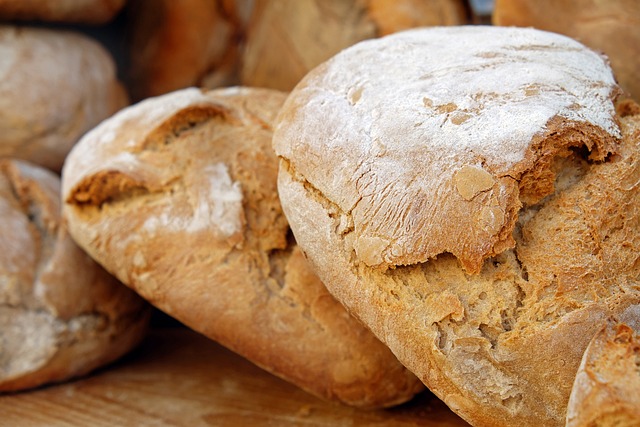By Tim Lambert
For thousands of years, until the end of the 19th century, bread was ‘the staff of life’ in Western Asia and most of Europe. Indeed, the word bread was sometimes a synonym for food. In Prehistoric Times, people ate flatbread. It’s believed that the Egyptians discovered leavened bread.
The staple food of the Egyptians was bread. The bread was baked outside, and because of the desert, sand was often blown into the dough. In time, eating bread with grains of sand in it wore down people’s teeth. The Greeks sometimes added olives or herbs to bread.
In Rome, bread was baked on a huge scale. A Roman bakery could bake bread for hundreds of people each day. The Romans had a goddess of bread making called Fornax.
Our word lady comes from an Anglo-Saxon word meaning ‘person who kneads dough’. Making bread was an important task, and usually, the leading woman in the household did it.
In the Middle Ages, rich people ate their food from slices of stale bread called trenchers. Afterward, they were given to the poor. Bread was such an important part of the diet of the ordinary people that the quality, weight, and price of loaves were regulated by law.
Bread was an important food for the rich and poor in Tudor Times, but it varied in quality. Rich people’s bread was made from fine white flour. Poor people ate coarse bread of barley or rye.
The sandwich is named after John Montagu (1718-1792), the Fourth Earl of Sandwich. It is said that he was so busy gambling that he asked for meat, fish, jam, etc., between two slices of bread so he did not have to leave the table.
With the Industrial Revolution, the mass production of bread began. For centuries, watermills and windmills were used to grind grain into flour. In the 19th century, mills powered by steam engines replaced them. Henry Jones invented self-raising flour in 1845.
In the USA, sliced bread went on sale in 1928. Sliced bread went on sale in Britain in 1930, but it was banned during the Second World War because the government wanted waxed paper for other uses. They also wanted to conserve the steel that was used in bread slicing machines. They didn’t start making it again in Britain until 1950.
In the USA, sliced bread was banned in January 1943. However, the ban proved to be very unpopular as people liked the convenience of sliced bread, and it was cancelled after less than 2 months.
Why do we say ‘the greatest thing since sliced bread’? When sliced bread went on sale, adverts called it ‘The greatest forward step in the baking industry since bread was wrapped’. Later, advertisers began to claim that their loaves were ‘the greatest thing since sliced bread’. In the 1950s, people began to use the phrase to describe anything, not just bread.
In Britain, bread was not rationed during the Second World War. However, it was rationed from 1946 to 1948.
Ciabatta bread was invented by Arnaldo Cavallari in 1982.
Since Ancient Egypt, bread has been used to make toast. Toast was eaten in Ancient Egypt. Toast was popular in Rome. Our word toast comes from the Latin word tostum, meaning burned or scorched. In the 17th century, people dunked toast into wine to make it less bitter. Shakespeare mentioned the practice. In The Merry Wives of Windsor, Falstaff says: Go fetch me a quart of sack; put a toast in it’. It became the custom to drink ‘a toast’ to someone.
The first electric toaster was invented in 1893 by Alan MacMasters. The pop-up toaster was invented in 1919 by Charles Strite. That made it easier to make toast without burning it.
There is a popular myth about bread: in the Middle Ages and the 16th century, in big houses, they cut the top off loaves of bread (because the bottom might be burned). The upper crust was given to the rich, and the burned bottom to the servants or the poor. Hence, we call the upper class the upper crust. Sometimes people cut off the loaf’s top ( mentioned in a book published in the 15th century).
But it’s most unlikely that it is the origin of the phrase. There is no evidence that the upper class was ever called the upper crust in the 16th century. The rich were first called the upper crust in the 19th century, long afterward. The phrase was probably just a joke, comparing them to the upper crust of a loaf or a pie. It probably has nothing to do with actual loaves.
Lastly, 16 October is World Bread Day. 17 November is National Homemade Bread Day.
